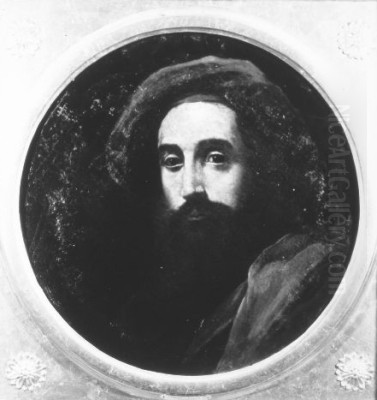
Massimo Stanzione stands as one of the most significant painters of the Italian Baroque period, particularly dominant in the vibrant artistic milieu of Naples during the first half of the 17th century. Active from the early decades until his likely death in the plague of 1656, Stanzione carved a unique path, skillfully blending the dramatic naturalism inherited from Caravaggio with the classical grace and refined palette associated with the Bolognese school, particularly Guido Reni. This synthesis earned him the laudatory, though perhaps simplifying, nickname "The Neapolitan Guido Reni," highlighting the elegance, delicate colour harmonies, and idealized beauty that characterized much of his output, setting him apart from some of his more starkly naturalistic contemporaries. His prolific career encompassed grand altarpieces, devotional paintings, historical and mythological scenes, and portraits, leaving an indelible mark on the visual culture of Naples and influencing generations of artists to follow.
Early Life and Artistic Formation in Naples
Born around 1585 or 1586 in Orta di Atella, a town near Naples, Massimo Stanzione entered an artistic world undergoing profound transformation. The late Mannerist style still held sway, but the revolutionary presence of Michelangelo Merisi da Caravaggio in Naples (first in 1606-1607, then again in 1609-1610) had irrevocably altered the artistic landscape. Caravaggio's dramatic use of chiaroscuro (strong contrasts of light and dark) and his unvarnished, often gritty realism sent shockwaves through the local artistic community.
Stanzione's initial training, according to the early biographer Bernardo De Dominici, was under Fabrizio Santafede, a respected local painter working in a competent, if somewhat conservative, late Mannerist style. This grounding would have provided Stanzione with solid technical skills in drawing and composition. However, the young artist quickly absorbed the lessons of Caravaggio, likely through observing his works directly in Neapolitan churches and collections, and through the interpretations of early Neapolitan Caravaggisti like Battistello Caracciolo. Caracciolo, one of the first Neapolitans to fully embrace Caravaggio's style, would have been an important local figure for Stanzione to study. Stanzione's early works, though not always securely dated, begin to show an engagement with tenebrism and a move towards greater naturalism than seen in Santafede's output.
The Roman Sojourn: Broadening Horizons
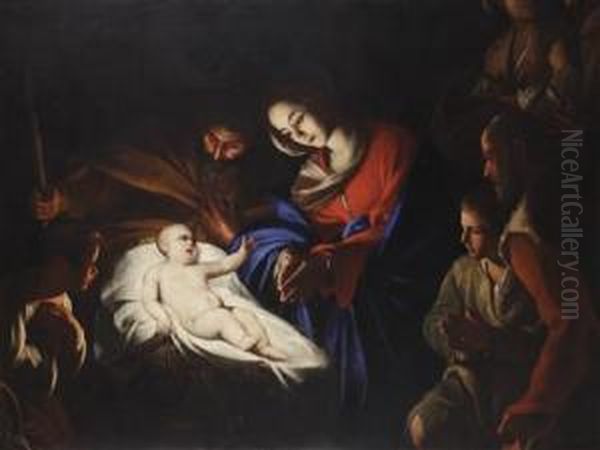
A pivotal period in Stanzione's development was his time spent in Rome, likely occurring between approximately 1617 and the mid-1620s, although precise dates remain debated among scholars. Rome, the undisputed centre of the European art world, offered an unparalleled opportunity for artistic education and exposure. Here, Stanzione encountered the full spectrum of early Baroque painting. He would have seen more works by Caravaggio himself and engaged with the diverse group of artists known as the Caravaggisti – followers who adapted Caravaggio's style in various ways. This included figures like Orazio Gentileschi and his talented daughter Artemisia Gentileschi, Simon Vouet, and Bartolomeo Manfredi.
Crucially, Rome also exposed Stanzione to the powerful counter-current to Caravaggism: the classical revival spearheaded by the Carracci family (Annibale and Agostino Carracci) and their followers from Bologna. Artists like Guido Reni and Domenichino championed a more idealized beauty, balanced compositions, lighter palettes, and graceful figures, drawing inspiration from Raphael and classical antiquity. Stanzione seems to have been particularly receptive to this Bolognese classicism. His Roman experience was therefore not about simply choosing one camp over the other, but about absorbing and synthesizing these seemingly opposing trends. He learned to temper the raw drama of Caravaggism with classical structure and elegance, a path also explored by artists like Simon Vouet before his return to France. This period was fundamental in shaping the refined and eclectic style that would become Stanzione's hallmark upon his return to Naples.
Return to Naples: Establishing a Dominant Position
Returning to Naples probably by the mid-1620s or early 1630s, Stanzione brought back a sophisticated style that found favour with patrons. Naples, under Spanish Viceregal rule, was a bustling metropolis and a major centre for artistic patronage, both ecclesiastical and private. Stanzione rapidly established himself as a leading painter, securing prestigious commissions for churches, monastic orders, and the nobility. He set up a large and productive workshop, which became a training ground for numerous younger artists.
His return coincided with the established presence of the Spanish painter Jusepe de Ribera, another giant of the Neapolitan Baroque. Ribera was a powerful master of Caravaggism, known for his intense realism, often depicting weathered saints and dramatic martyrdoms with unflinching detail. Stanzione offered a distinct alternative. While equally grounded in naturalistic observation, his figures were generally more idealized, his compositions more serene, and his emotional tone less stark than Ribera's. This elegant classicism appealed to a different sensibility, allowing Stanzione to carve out his own significant niche in the competitive Neapolitan art market. He and Ribera became the two dominant, though stylistically different, poles of Neapolitan painting for several decades.
The Signature Style: Synthesis and Elegance

Massimo Stanzione's mature style is best understood as a masterful synthesis. He retained the palpable realism and the dramatic potential of light learned from Caravaggio, but filtered these elements through a lens of classical order and Bolognese refinement. His chiaroscuro is often softer and more atmospheric than Caravaggio's stark tenebrism; light serves not just to create drama, but also to gently model forms and create a sense of volume and presence within a clearly defined space. Figures emerge from shadow, but the shadows themselves are often luminous and filled with subtle gradations.
His colour palette moved away from the predominantly earthy tones of the early Caravaggisti towards richer, more varied, and often brighter hues, reminiscent of Reni and even Venetian masters like Titian. He employed harmonious colour combinations, contributing to the overall elegance and decorative quality of his work. Compositions are typically balanced and well-structured, often employing pyramidal or diagonal arrangements derived from High Renaissance and classical principles. Figures possess a tangible weight and volume, yet move with grace and dignity. Even in scenes of potential violence or intense emotion, such as his depictions of Lucretia or Judith with the Head of Holofernes, there is often a sense of classical restraint and psychological nuance rather than overt melodrama. This inherent elegance and refinement are the qualities that most strongly link him to Guido Reni and justify his enduring nickname.
Major Works and Thematic Concerns
Stanzione was exceptionally prolific, and his works graced many of Naples' most important churches and collections. Religious subjects formed the core of his production, reflecting the demands of the Counter-Reformation Church. He painted numerous altarpieces, large-scale narrative scenes from the Old and New Testaments, and devotional images of the Madonna and Child and individual saints. Among his celebrated works are the Adoration of the Shepherds (c. 1627), showcasing his ability to handle complex multi-figure compositions with clarity and warmth. His depictions of the Annunciation and various Madonna and Child compositions are noted for their tender sentiment and graceful figures.
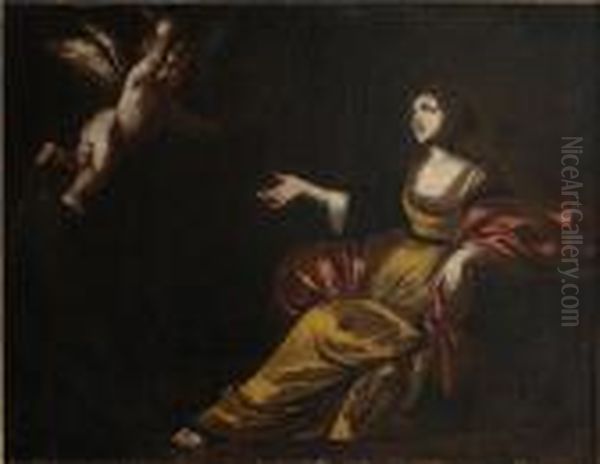
He excelled in portraying female figures, both biblical heroines and saints. His Judith with the Head of Holofernes (examples in the Metropolitan Museum of Art, New York, and private collections) presents a determined but composed heroine, contrasting with the more visceral interpretations by artists like Artemisia Gentileschi. His depictions of Saint Agnes or Lucretia combine physical beauty with inner strength and pathos. Stanzione was also a master of fresco painting, contributing significantly to major decorative cycles. His work in the Certosa di San Martino, particularly in the Chapel of St. Bruno, and frescoes in San Paolo Maggiore (including the ceiling of the sacristy) demonstrate his skill on a monumental scale. The altarpiece San Patrobo predica ai fedeli di Pozzuoli (St. Patrobus Preaching to the Faithful of Pozzuoli) is another example of his large-scale public commissions. While primarily known for religious themes, he also undertook mythological subjects and portraiture, although fewer examples of the latter survive.
The Workshop, Collaborations, and Artistic Dialogue
Massimo Stanzione operated one of the most important artistic workshops in Naples. This studio not only produced a vast quantity of work under his supervision but also served as a crucial training centre. His influence was disseminated through his many pupils and assistants who absorbed his style and techniques. Among the most notable figures associated with his workshop was Diana de Rosa, also known as Annella di Massimo. She was a talented painter in her own right, and Stanzione's support for her career was significant in an era when female artists faced considerable obstacles. Her tragic life story, as recounted by De Dominici, though possibly embellished, highlights her connection to Stanzione's studio.
A particularly significant relationship was Stanzione's friendship and artistic dialogue with Artemisia Gentileschi, who resided in Naples from 1630 until her death (with brief interruptions). Documents and stylistic analysis suggest a mutual respect and likely collaboration or shared influence. Some scholars propose that Artemisia's dynamic compositions and rich colour sense may have impacted Stanzione, while his elegance might have subtly influenced her later Neapolitan works. They were certainly key figures working for the same patrons and contributing to major projects, such as the cycle for the Pozzuoli Cathedral. Stanzione also seems to have had connections with other specialists, potentially collaborating with artists like the landscape and battle painter Domenico Gargiulo, known as Micco Spadaro, integrating their contributions into larger compositions.
Stanzione within the Neapolitan Context
To fully appreciate Stanzione's achievement, it's essential to view him within the rich tapestry of Neapolitan Baroque art. He was a contemporary of the formidable Jusepe de Ribera, whose powerful, often tenebrist realism dominated the scene for decades. Stanzione provided a crucial counterpoint, offering a more classical, elegant, and colourful alternative that appealed greatly to local tastes. He also worked alongside Battistello Caracciolo in the earlier phase, and later contemporaries included the poetic and distinctive Bernardo Cavallino, whose delicate style offered yet another facet of Neapolitan painting.
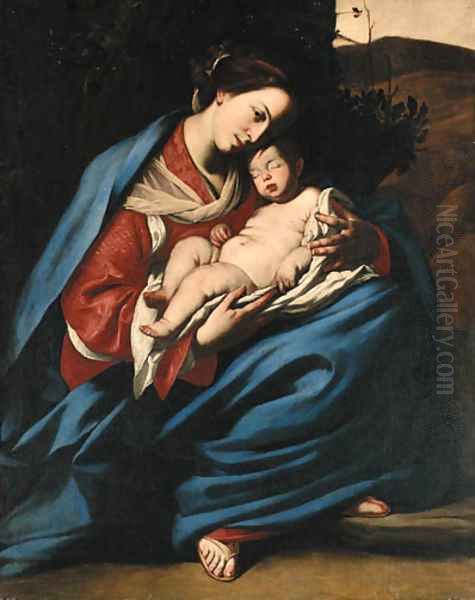
The arrival of other major artists in Naples further enriched the environment. Giovanni Lanfranco worked there, bringing his High Baroque dynamism. Later, the immensely energetic Mattia Preti spent time in the city, introducing a more dramatic and fluid style. Stanzione navigated this complex and competitive scene successfully, maintaining his position as a leading master through the quality and appeal of his work. He played a central role in defining what is often termed the "Neapolitan School," characterized by its synthesis of Caravaggesque naturalism with diverse influences, including Spanish realism (via Ribera) and Bolognese classicism (championed by Stanzione). His success contributed significantly to Naples' reputation as a major European art centre, rivaling Rome and Venice.
Later Career, Death, and Enduring Legacy
Massimo Stanzione remained active and highly sought after throughout the 1640s and into the 1650s. His style continued to evolve subtly, but he remained committed to the principles of clarity, elegance, and refined naturalism that had brought him success. His long and productive career was likely cut short by the devastating plague that struck Naples in 1656. This epidemic claimed the lives of many artists, including Bernardo Cavallino, and Stanzione is generally believed to have been among its victims.
His legacy, however, was profound and lasting. Through his numerous works and the activity of his large workshop, he exerted a dominant influence on Neapolitan painting in the mid-17th century. His most important successor was Francesco Solimena, who trained initially in the tradition established by Stanzione and went on to become the leading Neapolitan painter of the late Baroque and early Rococo periods, carrying forward elements of Stanzione's grandeur and compositional clarity. Stanzione's influence can also be detected in the work of Andrea Vaccaro and many other painters active in Naples and Southern Italy. He successfully forged a distinctive Neapolitan Baroque style that balanced drama with elegance, naturalism with idealization, leaving behind a corpus of work celebrated for its technical mastery, compositional harmony, and serene beauty.
Stanzione's Works in Collections Today
Today, Massimo Stanzione's paintings are held in major museums and collections around the world, although the greatest concentration remains in Naples itself. The Museo Nazionale di Capodimonte in Naples houses a significant collection of his masterpieces, offering a comprehensive overview of his career. His frescoes and altarpieces can still be seen in situ in important Neapolitan churches, most notably the Certosa di San Martino and San Paolo Maggiore, as well as churches in Pozzuoli and elsewhere in the region.
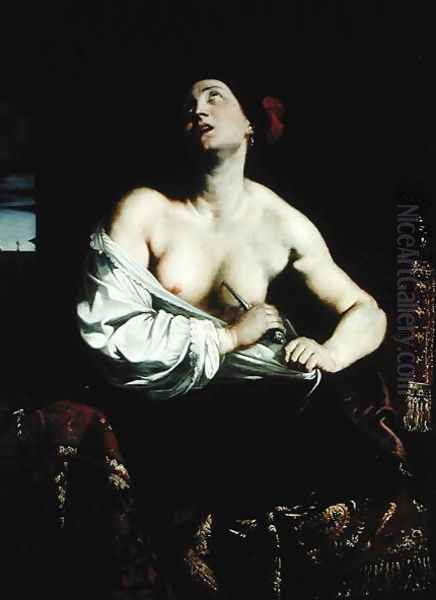
Internationally, his works are represented in prominent institutions such as the Louvre Museum in Paris, the Metropolitan Museum of Art in New York (which holds the notable Judith with the Head of Holofernes), the Seattle Art Museum (home to an Assumption of the Virgin), the Prado Museum in Madrid, and numerous other European and American museums. Works also appear in private collections and periodically surface on the international art market, attesting to his continued appreciation by collectors and connoisseurs. Studying these works allows us to trace the development of a master who skillfully navigated the complex artistic currents of his time to create a style that was both deeply Neapolitan and universally appealing in its refined elegance.
Conclusion: A Pillar of the Neapolitan Baroque
Massimo Stanzione remains a pivotal figure in the history of Italian Baroque art. As the "Neapolitan Guido Reni," he offered a compelling vision that merged the visceral impact of Caravaggism with the grace and harmony of classicism. His ability to synthesize these trends, combined with his technical brilliance, compositional skill, and refined sensibility, made him one of the most successful and influential painters in 17th-century Naples. His prolific output, the activity of his workshop, and his dialogue with contemporaries like Ribera and Artemisia Gentileschi shaped the course of the Neapolitan school. More than just an imitator, Stanzione forged a distinct artistic identity, leaving behind a legacy of elegant, emotionally resonant works that continue to captivate viewers with their serene beauty and masterful execution. He stands as a testament to the richness and diversity of the Baroque era in Naples, a city that, thanks to artists like him, shone brightly as a major centre of European art.